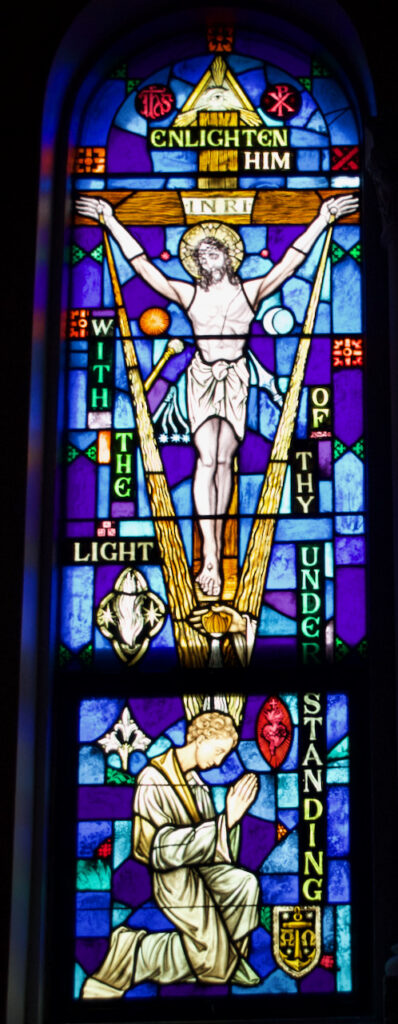
The Easter season is a time of Baptism. Catechumens are Baptized at the Easter Vigil and we renew our Baptismal Promises at the Easter liturgies. In the back of the church is the Baptistry, a room in which Baptisms were held before they were moved to the sanctuary. Its four windows provide a profound teaching on the sacrament. They are some of the most beautiful and symbolic windows in the church. In Baptism we are freed from sin, sharing in the death of Jesus, and are born to new life in Christ as sons and daughters of God and we become members of the Church.
At the beginning of the Rite of Baptism, the sign of the cross is traced on the forehead of the person receiving the sacrament, claiming him or her for Christ. An image of the crucified Jesus dominates the first window, reminding us of the integral connection between the death of Christ and this sacrament. The whip, sponge, and lance, symbols of his Passion and suffering, are on the sides of the cross. At the top of the window is a triangle containing an eye with rays of light extending from it, a representation of the Trinity, present at the moment of Jesus’ crucifixion, and present at this moment of Baptism.
A hand is pouring water from a shell upon the head of the person being baptized and it is united with rays of light flowing from the wounded hands of the crucified Savior. Baptism “…signifies and actually brings about death to sin and entry into the life of the Most Holy Trinity through configuration to the Paschal mystery of Christ.” (CCC 1239) The words surrounding the images remind us that in our Baptism we receive divine enlightenment. The flame with the two stars to the left of the hand might symbolize the guidance we now receive through this enlightenment.
Other symbols in this window can further our understanding of the sacrament and our prayer. IHS and the Chi Rho beside the triangle are Greek forms of Jesus’ name. The sun and moon beneath Jesus’ arms might suggest the new creation born of His death and resurrection. Lilies symbolize purity, innocence, and eternal life. The three lilies also suggest a fleur-de-lis, representing the resurrection and the Trinity. The image of the Sacred Heart of Jesus, of His infinite and unconditional love for us, is enclosed in a mandorla, the oval shape of new birth. The alpha and omega and anchor represent the Church.
Before moving on to the other windows let us pause and consider what it means that we share in the death and resurrection of Jesus through our Baptism and that we now live in Christ as sons and daughters of God.
Reference
Catholic Church. (1994). Catechism of the Catholic Church. Vatican City: Libreria Editrice Vaticana.